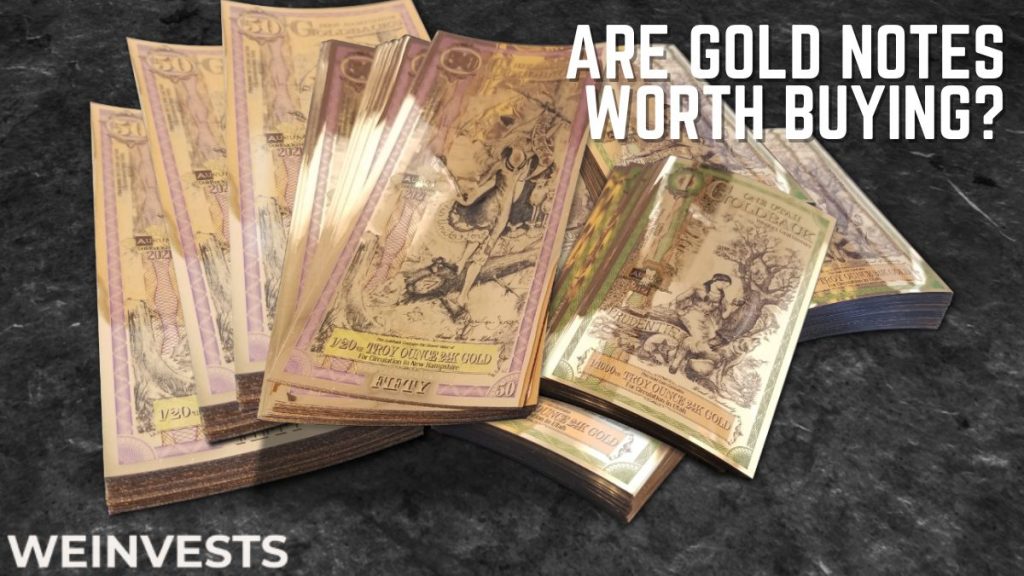Gold notes, often referred to as ‘Goldbacks,’ have emerged as a notable option for investors exploring diversification with tangible assets. Central to their appeal is their backing by gold, which positions them as a potential hedge against inflation and a source of stable value. However, their acceptance compared to traditional currencies remains limited, raising questions about their practicality.
This article focuses on the topic: “Are Gold Notes Worth Buying?” We will dissect what gold notes are, how they operate, and critically assess their advantages and disadvantages. Our aim is to equip you with a nuanced understanding of gold notes, helping you ascertain their suitability for your investment strategy.

Table of Contents
Is Gold Notes A Good Investment?
Let’s tackle what we’d like to learn first thing, Investing in gold notes can be an effective strategy for diversifying a portfolio and safeguarding wealth against inflation and economic volatility.
As gold notes are backed by physical gold, they tend to retain value even during economic downturns, contrasting with paper currency that can depreciate due to factors like inflation or governmental policies.
Key advantages of gold notes include their ease of storage and transport, given their small size and weight, and the privacy they offer, as they are not registered with financial institutions or government agencies.
For those considering investing in gold notes, many online users recommend eToro as a user-friendly platform to explore such investments.
However, it’s vital to recognize the risks associated with gold notes. Their value can fluctuate with the gold market, selling them may not always yield the desired price, and, being physical assets, they are susceptible to loss or theft. Hence, it’s crucial to consider these risks thoroughly before investing in gold notes.
Benefits of Gold Notes
Gold notes are a unique form of currency that have numerous benefits for both individuals and businesses. Here are some of the key benefits of using Goldbacks:
- Interchangeable: Goldbacks are designed to be interchangeable, meaning they can be used for even small transactions. This solves a problem that has existed for over 2,600 years by allowing gold to be spent in small, interchangeable amounts.
- Increased Value: Gold has increased in value by around 30% in the last five years in the four largest currencies. This means that gold notes could potentially increase in value over time.
- Protection against inflation: Gold has been a reliable store of value for thousands of years, and gold notes allow individuals to hold physical gold as a form of currency. This means that gold notes can potentially protect against inflation and currency devaluation.
- Portability: Gold note is a portable and convenient way to own physical gold. Unlike other forms of gold ownership, such as gold coins or bars, Goldbacks are easy to carry and can be used for small transactions. You can put gold notes in your wallets as you would a dollar.
- Security: Goldbacks are tamper-proof and counterfeit-resistant. They are made using advanced vacuum deposition technology, which creates a layer of gold that is just a few atoms thick. This makes it virtually impossible to counterfeit a Goldback.
- Fungible: Two 5 Goldbacks are equal to one 10 Goldback, making them fungible. This makes transactions easier and more convenient.
- Business Support: Businesses can register for free as a ‘We Accept The Goldback’ enterprise and receive advertising and instructions on how to accept Goldbacks. This can help businesses attract new customers and expand their offerings.
- Actual Gold: A gold note is not a promise to pay in gold but is the actual gold itself. This gives individuals peace of mind knowing they are holding onto a valuable asset.
- Local economic support: Using Goldbacks supports local businesses and helps to educate people about money. This can help to create a more vibrant local economy and promote financial education.
- Diversification: Goldbacks offer a way to diversify one’s portfolio. Gold has historically been a safe haven asset during times of economic uncertainty, and owning physical gold in the form of Goldbacks can help to diversify one’s investments.
Overall, Goldbacks offer many benefits to individuals and businesses. They provide a unique way to own physical gold and can potentially protect against inflation and currency devaluation. They are also portable, secure, and flexible and can support local businesses and promote financial education.
Risks of Investing in Gold Notes
While investing always carries inherent risks, understanding the specific challenges of gold notes is vital. Let’s dive into what makes these investments uniquely risky and compelling.
Gold prices can be volatile and can fluctuate due to a series of factors such as economic conditions, global events, and changes in supply and demand. This volatility can lead to significant fluctuations in the value of gold notes.
Gold notes are issued by a private company in Utah, which means investors could be exposed to counterparty risk. If the issuer defaults or goes bankrupt, investors may lose some or all of their investments.
Gold notes may not be as liquid as other investments, such as stocks or bonds, making it difficult for investors to sell their holdings quickly or at a favorable value. Also, there is no guarantee that you will be able to sell your gold note for its face value when you need to liquidate it.
Changes in interest rates can affect the value of gold notes. For example, if interest rates rise, the value of the notes may decline, as investors may shift their investments to higher-yielding assets.
The value of gold notes may be affected by inflation, as the currency used to purchase them may lose its purchasing power.
Some jurisdictions have special tax rules that apply to gold investments, which can reduce the overall return on investment.
Gold notes may be denominated in a currency different from the investor’s home currency, exposing them to exchange rate fluctuations.
A buyer can never know for certain whether the note is real or counterfeit.
Gold notes are not FDIC insured. If an issuer goes bankrupt or closes down, you could lose some or all of your money.
Gold notes can be a valuable addition to a diversified investment portfolio. However, before investing, it’s important to do your research and consider these factors in order to ensure that Gold notes are the right investment option for you.
What’s the Market for Gold Notes?
If you’re considering purchasing Gold notes, it’s important to understand how they work and what they can do for you.
Goldbacks are not widely accepted as currency, but they are recognized as a legitimate form of currency by the US government. Goldback notes are relatively new to the market, so their limited circulation means that there is little liquidity in the marketplace. It may be challenging to find sellers who are willing to accept Goldbacks for payment. However, you can find a comprehensive map or locations of local businesses that accept Gold notes in some states in the U.S.
The value of gold notes is directly linked to the current market value of gold, which can fluctuate with changes in the price of gold. However, unlike traditional paper currency, the value of gold notes is backed by their physical gold content, which can provide a level of stability and security for holders of these notes. Some people view Gold notes as a way to protect against inflation or economic instability, while others enjoy owning them as a unique piece of currency.
Finally, Its important to note that Gold notes are NOT backed by the US government or any other government. Instead, they are backed by physical gold, with each note containing a specific amount of gold that determines its value.
What are Gold Notes?
Gold Notes are a type of currency that is backed by physical gold. Although not widely accepted as legal tender, they are recognized as currency and can be used for local transactions in areas where they are accepted. Goldback Notes were first issued in 2018 by Utah-based company Goldback Inc., which continues to produce them exclusively. They are currently available in several states in the US, including Utah, Nevada, New Hampshire, and Wyoming.
Goldback notes are made from a thin layer of 24-karat gold, which is sandwiched between layers of polyester film. Each note features unique designs that showcase various themes, such as nature or history. The value of Goldback Notes is determined by the amount of gold they contain, which ranges from 1/1000th of an ounce to 1/20th of an ounce. So, for instance, a Gold note that contains 1/1000th of an ounce of gold would have a lower value than a Gold note that contains 1/20th of an ounce of gold.
As a form of alternative currency, Goldback Notes provide an interesting option for individuals looking to diversify their investments and protect against inflation. The combination of artistic designs and tangible gold value also makes Goldback notes an intriguing collector’s item
Where Are Gold Notes Accepted?
Gold notes, a.k.a “Goldbacks,” are a type of currency that can only be used in a limited number of states in the United States. These states include Utah, Nevada, New Hampshire, and Wyoming, and only a select number of businesses in these areas accept gold notes as payment. However, they can be traded or sold to collectors or investors worldwide.
Purchasing gold notes can be done in several ways, with the most common method being through an online gold note issuer or gold dealer. The value of gold notes can vary based on the purchase method and intended resale value. Also, the denominations of each note determine its worth in gold, so higher-value notes can be more expensive to purchase.
While gold notes offer a unique investment opportunity with their own set of advantages, it’s important to consider the broader spectrum of precious metal investments. If you’re weighing your options in the precious metals market, our article about silver offers an insightful comparison.
Silver, often seen as gold’s more affordable counterpart, has its own market dynamics and investment potential. Understanding the nuances of silver investments could help you make a more informed decision about diversifying your portfolio with precious metals.
In addition to Silver ,Platinum, known for its rarity and unique properties, stands as a distinct choice in the realm of precious metals investments. Grasping the intricacies of the platinum market is key to discerning its role in diversifying your investment portfolio. Unlike more common metals, platinum’s value is tied to its industrial demand as well as its status as a luxury item, offering a different perspective on investing in precious metals.
Conclusion
Gold notes are a type of currency backed by gold. They can be used to buy goods and services just like regular currencies. However, they are still a relatively new field that needs to be explored. If you want to get into this market, you’ll need to understand what you’re getting into and how to get started. If you’re looking to invest in gold notes, be sure you do your research before making any decisions.
FAQ
Is Gold note a legal tender?
No, Gold notes are only accepted by some merchants in Utah, New Hampshire, Nevada, and Wyoming
How are Gold notes issued?
Gold notes are issued by Goldback Inc. a private company in Utah USA
Where can I buy gold notes?
You can buy gold notes online or at a physical store where you can exchange fiat for its value in gold note.
WeInvests is a financial portal-based research agency. We do our utmost best to offer reliable and unbiased information about crypto, finance, trading and stocks. However, we do not offer financial advice and users should always carry out their own research.
Read More









